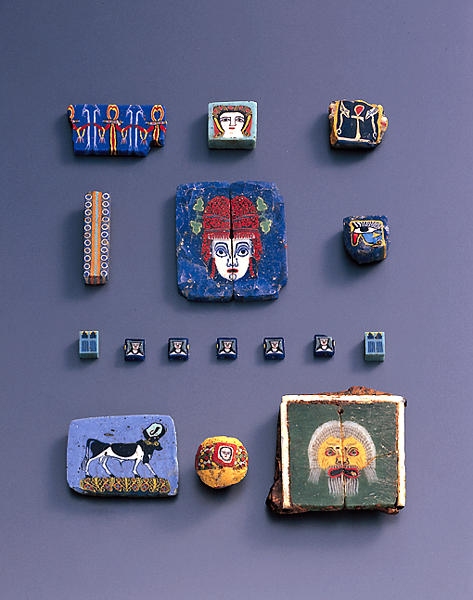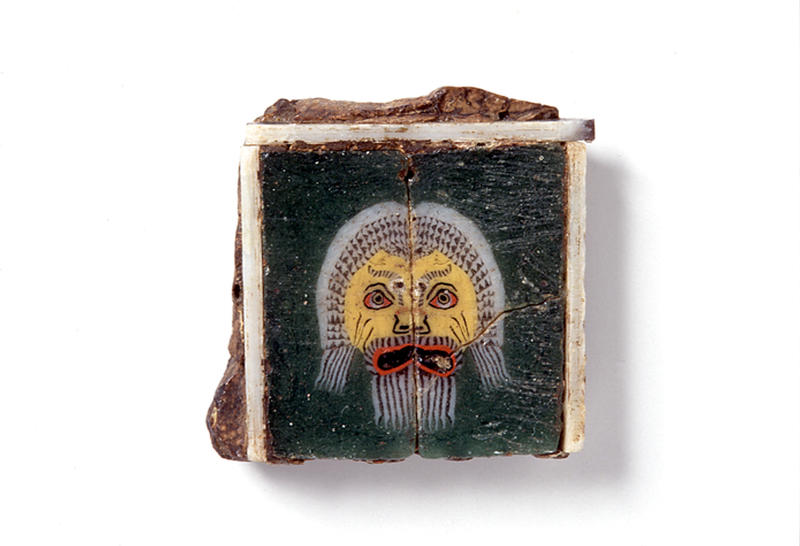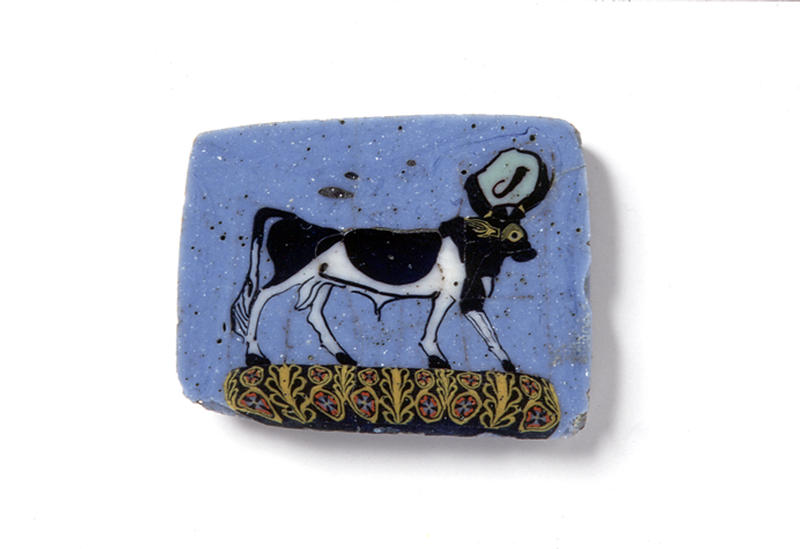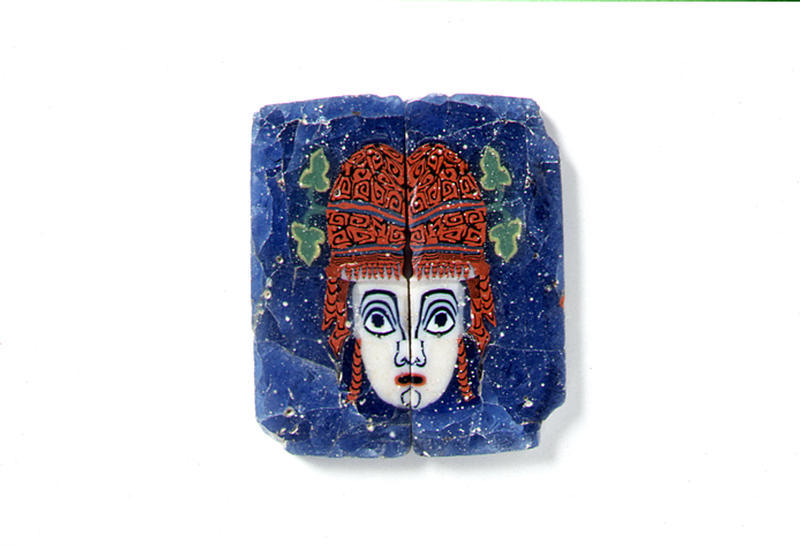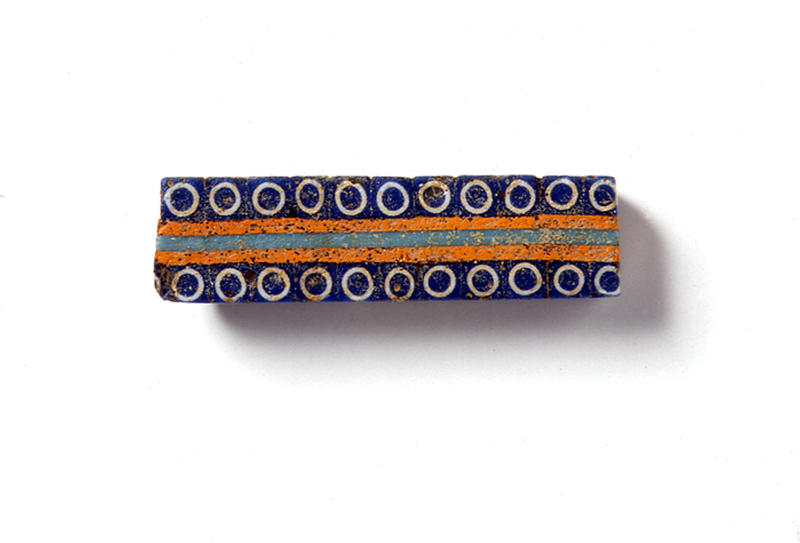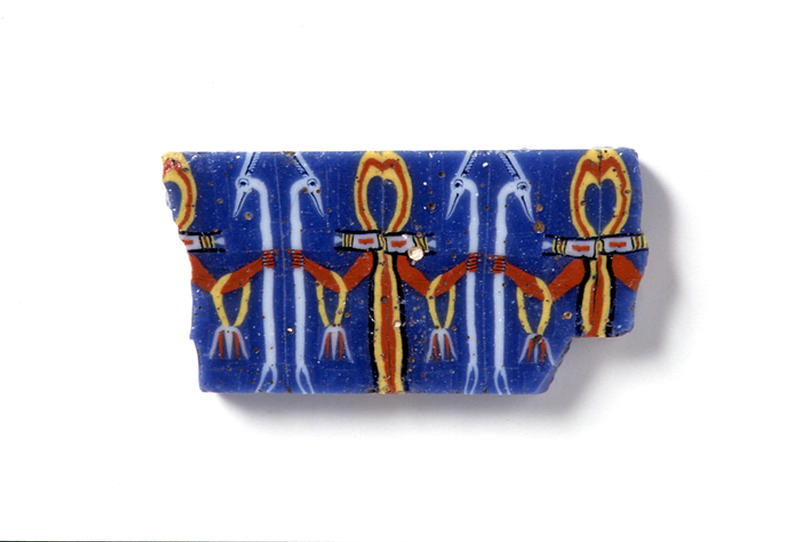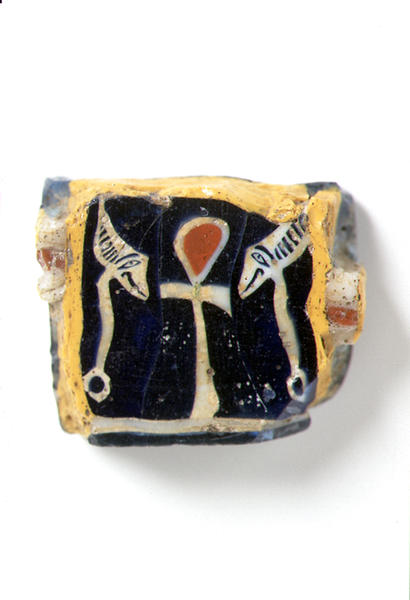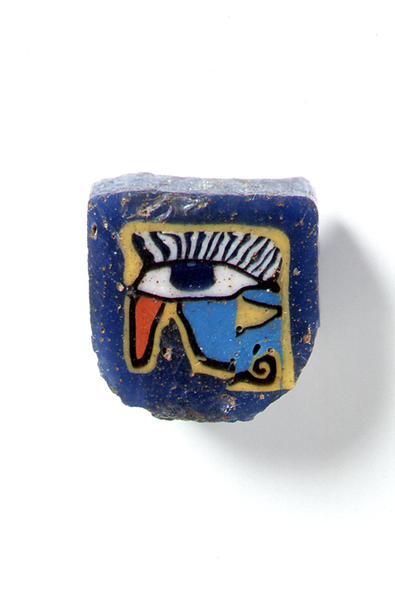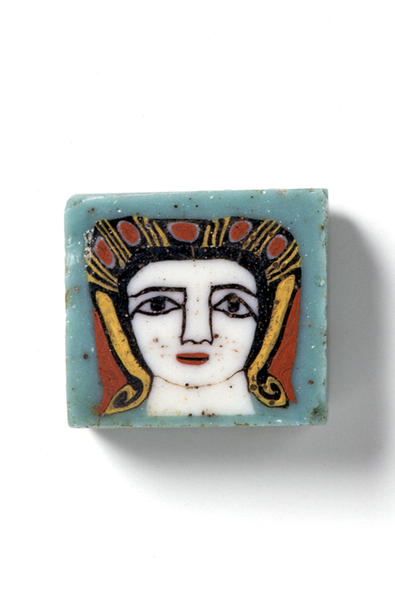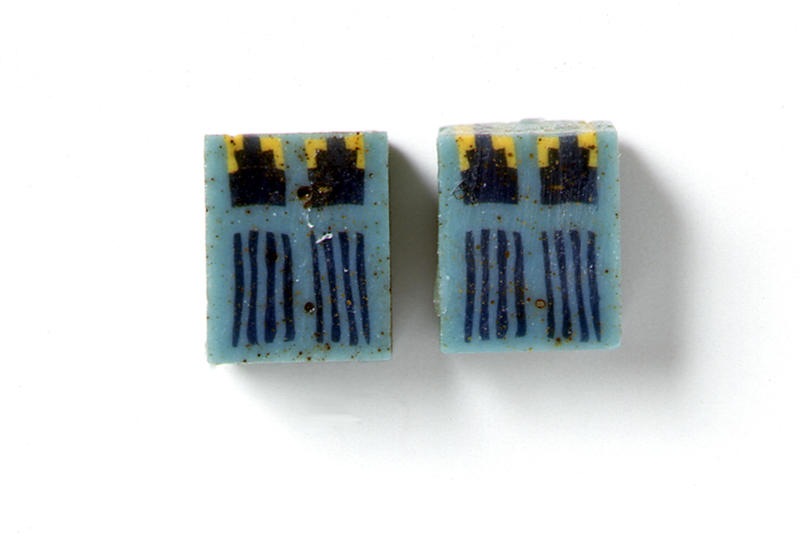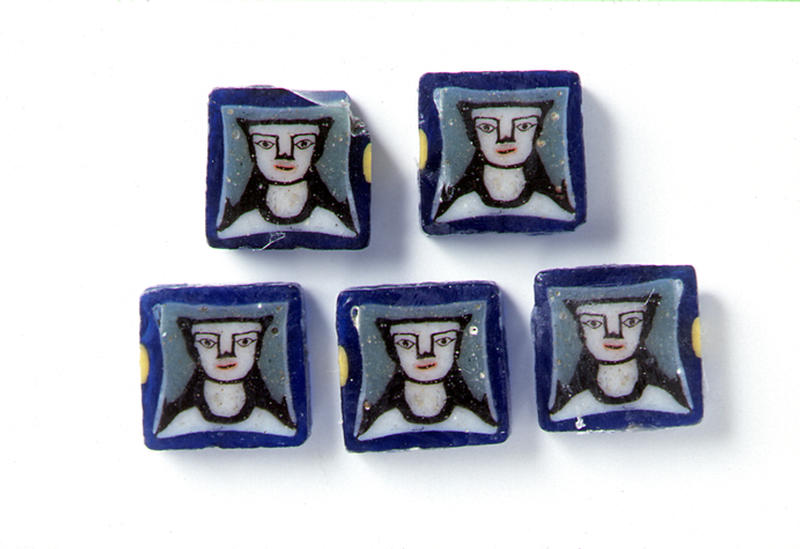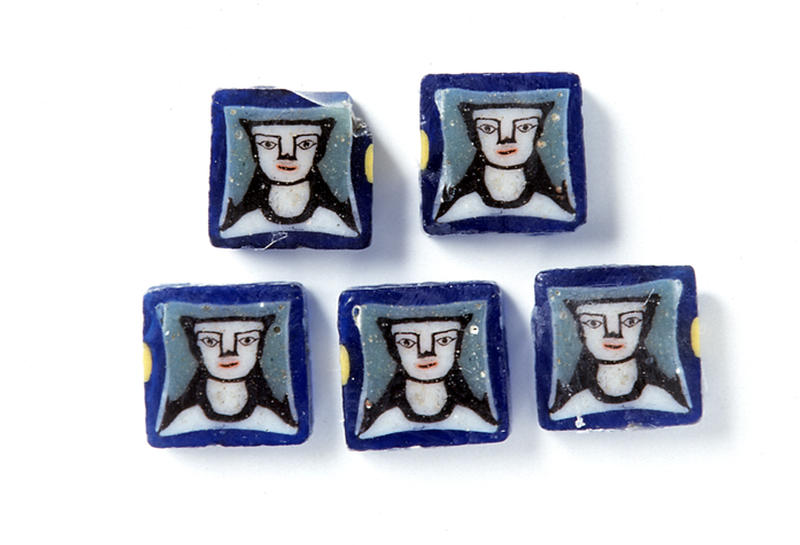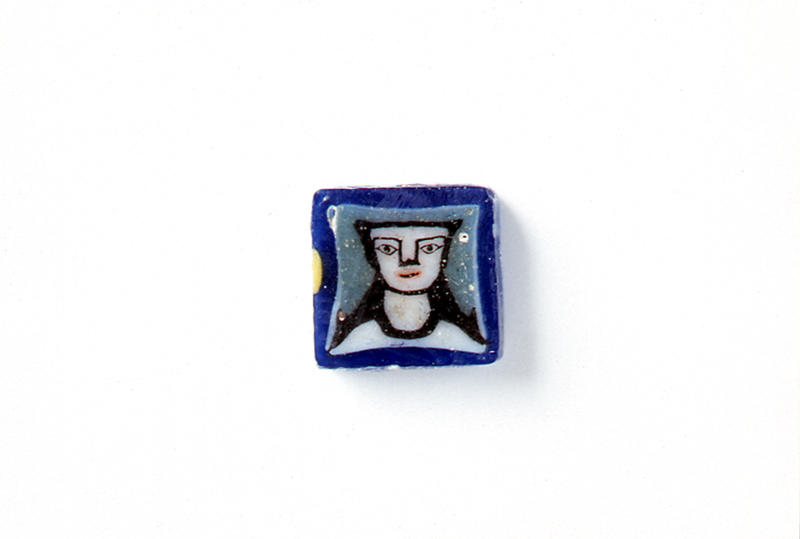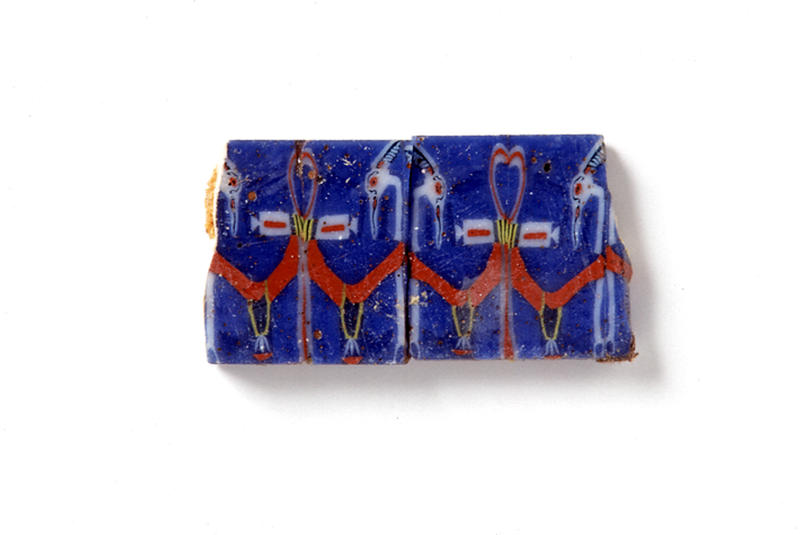Mosaic Glass Inlays
- Egypt
- Late Ptolemaic to Roman period
- 1st century B.C. - 1st century A.D.
- Glass
- H-3.5
Catalogue Entry
Beautifully colored, intricately detailed inlays of mosaic glass decorated the furnishings and walls of palaces and public buildings in late Ptolemaic Egypt and in Imperial Rome. These are not to be confused with floor or wall mosaics in which various stone tesserae, each of a single color, were set into plaster to form a design. Mosaic glass was a medium unto itself in which long rods of glass, each a different color, were bundled together so that they formed a pattern visible on the end and in cross-section. They were then heated till they fused, and when cool, were sliced, each slice containing the image desired.
The technique is thought to have been invented in Egypt because the subjects are often Egyptian in nature, and many examples have been excavated there. Mosaic glass's popularity around Rome suggests that workshops were established there as well.1
A: Rectangular plaque with frieze of hieroglyphic signs: ankhs (the hieroglyph for "life," Gardiner S34) alternating with a pair of addorsed was-scepters (the hieroglyph for royal authority, Gardiner S40); in the interstices is an undetermined sign, possibly the ideogram for "sunshine" (Gardiner N8).2 This series of signs is repeated twice and the ankh appears once more. A more complex example was found by Sir Flinders Petrie at Dendera in Upper Egypt and is now in the British Museum, London.3 Similar to the latter is an example in Corning, New York,4 and another in the Freer Gallery of Art, Washington, D.C.5 Other inlays with was and ankh are in the British Museum,6 in the former Kofler-Truniger7 and Per-neb collections.8
B: Square plaque with ankh flanked by was-scepters.9
C: Square plaque with wedjat-eye or eye of Horus, the falcon god. The eye of Horus was a general good-luck amulet and also warded off the evil eye. Furthermore, when turned left, it symbolized the moon; when turned right, the sun. A mosaic slice could have been turned either way. Various parts of the eye were also used as fractional symbols. An example of similar design but different color was found by Petrie at Dendera and is in the British Museum.10 Three eye plaques are in Corning,11 one in Toledo,12 and several examples of various designs were in the Kofler-Truniger collection.13
D: Rectangular plaque with striding Apis bull.14 An exact duplicate, perhaps from the same rod, is in Corning,15 and another is in the Freer Gallery,16 both said to have come from Egypt. An Apis bull within a complex border was in the Kofler-Truniger collection.17
E: Rectangular fragment with geometric border, a vertical line flanked by single rows of tiny circles, perhaps an abstracted form of a cobra's body.18 A less complete version was in the Kofler-Truniger collection.19
F: Two-part mask of a maenad, female companion of Dionysos, identified by her grape-leaf crown. An identical inlay has been in two London sales.20 Others are in Corning,21 Toledo,22 and another formerly Kofler-Truniger.23
G: Framed New Comedy theater mask, identified as such by the gaping down-turned mouth and the fact that it lacks the satyr's or silen's grape-leaf crown. A near duplicate without frame was in a London sale.24 A less similar comedy mask is in the British Museum.25 Two others (called silenus and satyr) are in Corning,26 and two others formerly Kofler-Truniger.27
H: Square plaque with mask of Hathor, an Egyptian mother goddess, identified by her long tresses with single curl at bottom. Other Hathor plaques, not close in style, are in Corning.28
I: Five small square plaques with frontal human faces, perhaps Hathor,29 and two rectangular plaques with the traditional Egyptian design representing a palace (serekh) facade.30
J: Spherical bead with mask and checkerboard pattern. A spherical bead with mask mounted in gold is in the Kestner-Museum Hannover.31 Several others are strung together in the former Kofler-Truniger collection.32
APK
1. For discussions on the origin and uses of mosaic glass, see Harden 1987, pp. 16, 31-33;
Goldstein 1979, pp. 40-41.
2. Gardiner 1966, p. 486 (N8), p. 508 (S34), p. 509 (S40).
3. Harden et al. 1968, p. 26, no. 23 (E. 64224); Cooney 1974, p. 111, no. 1143, pl. IV.
4. Goldstein 1979, p. 228, no. 664.
5. Ettinghausen 1962, p. 20, fig. 55, pl. opp. p. 18.
6. Cooney 1974, p. 131, no. 1628, p. 132, no. 1638, p. 140, nos. 1723-26.
7. Christie's 1985, pp. 120-21, no. 227 (second from left), pp. 122-25, nos. 239m, 241m, pp. 128-29, nos. 245, 246h.
8. Christie's 1992, p. 18, no. 25.
9. See references for item A.
10. Harden et al. 1968, p. 26, no. 24; Cooney 1974, p. 112, no. 1149, pl. IV.
11. Goldstein 1979, pp. 227-28, nos. 661-63.
12. Grose 1989, p. 362, no. 630.
13. Christie's 1985, pp. 124-25, no. 241 d, pp. 128-29, nos. 246 (several examples).
14. Published: Christie's 1992, p. 17, no. 23.
15. Goldstein 1979, pp. 235-36, no. 684, there shown facing the opposite direction. See this reference for additional parallels. Three slices of Apis plaques are in the same collection: ibid., p. 235, no. 683.
16. Ettinghausen 1962, p. 18, fig. 53, pl. opp. p. 18.
17. Christie's 1985, p. 132, no. 251.
18. See cobra bar in Goldstein 1979, p. 231, no. 672.
19. Christie's 1985, pp. 120-21, no. 227 (third from left).
20. Christie's 1992, p. 13, no. 14; Christie's 1997, p. 26, no. 46.
21. Goldstein 1979, pp. 238-39, nos. 691-93.
22. Grose 1989, p. 362, no. 627.
23. Christie's 1985, p. 131, no. 250c.
24. Christie's 1992, p. 12, no. 11.
25. Harden et al. 1968, p. 26, no. 22; Cooney 1974, p. 140, no. 1682, pl. V.
26. Goldstein 1979, pp. 237-38, nos. 688-90.
27. Christie's 1985, p. 130, no. 249 (two in center).
28. Goldstein 1979, p. 236, nos. 686-87.
29. See references for item H.
30. Cooney 1974, p. 112, no. 1147, pl. IV.
31. Liepmann 1982, p. 125, no. 164, back cover.
32. Christie's 1985, p. 133, no. 252.
Catalogue Entry / Collar
Collar decoration made up of four ranks of vegetation motif. Rows of white lotuses, yellow flowers, white flowers, and white flower petals are all divided by thin orange lines and shown against alternating cobalt and red grounds. This fragment would have been used as an inlay element.
Catalogue Entry / Apis Bull
Decorative plaque depicting the Apis bull. The Apis bull was a sacred bull who was either a manifestation of Ptah, the main god of Memphis, or his envoy. The bull is depicted in cobalt and white against a pale blue ground as he strides across a dais decorated with plant motifs. A sun disk of turquoise glass depicting the sacred snake uraeus is shown between his horns. The details of the bull are depicted in cobalt and yellow, while the dais is expressed in cobalt, yellow, red and gray. The vegetation motif on the dais is Greek in style and this decorative panel reveals a pairing of Egyptian thematic motifs and Greek thematic motifs. Other plaques thought to have been cut from the same glass rod are in two American museums, the Corning Museum of Glass and the Freer Art Gallery.
Catalogue Entry / Goddess Hathor
A square decorative panel showing a woman's face depicted in white, dark purple, red and yellow against a turquoise ground. The tips of her long hair are curled, and it is surmised that she represents the earth goddess Hathor.
Catalogue Entry / Females
Small decorative panel showing a woman's upper body. The figure is depicted in white, black and red on a turquoise ground, surrounded by a cobalt border. This might also be an image of Hathor. All five fragments are from the same mosaic glass rod.
Catalogue Entry / Ankhs and Was-scepters
These rectangular decorative panels show a combination of two heiroglyphs, the ankh and was-scepters, with the ankh made up of a T-shaped form topped by a circle and symbolizing life. The was-scepters has the head of a dog-like animal with the lower extremities made into a two-pronged scepter, and symbolizes royal authority. The motifs are depicted in red, white, yellow, and cobalt against either a blue or cobalt background. In (a) the ankh is flanked on both sides by was-scepters and the overall area is framed. It appears that other motifs at one point existed outside the framing. (b) - (d) show a repetition of an ankh symbol grasping the was-scepters with both outstretched arms. Decorative bracelets hang from the arms of the ankhs. These decorative panels are made up of mosaic glass units consisting of half of an ankh and the was-scepters which are then paired front to back to make a single motif element and then connected with other elements of the same construct.
Ankh and Was Scepter
Catalogue Entry / Palaces
The front of a palace is shown in cobalt and yellow on a turguise ground.
Catalogue Entry / Maenad
This rectangular decorative plaque shows a white female mask on a blue ground. Made from the alignment of two half faces. The three curls hang down by the cheeks and the face is crowned with an ivy crown. There details are expressed in red, green, blue and yellow. Maenad was an attendant to the Greek god Dionysos and is said to have been a woman who danced and sang in the mountain fields when she was drunk.
Catalogue Entry / Old Person
This rectangular decorative plaque shows a male mask in yellow against a green ground. Made from the alignment of two half faces. This face has a long, flowing white beard. The tips of his white hair slso hang down. The details are depicted in yellow, dark purple, white and red. This plaque has been surrounded by a white glass frame on three sides, which was then barked with dark purple glass. This figure is thought to represent one of the actors in the Greek theatre called the New Comedy.
Catalogue Entry / Mosaic Face Beads
Mosaic glass was used for the decoration of beads. These beads have mosaics of human face designs inlaid into their surface. The white face is depicted with details in red and black. These faces are either arranged in a line around the center of the bead, or they are interchanged with mosaic abstract patterns. There are two types of face seen in these beads, with either the upper body of a woman shown, or just her face. The face-only images are said to represent the mask of Medusa, one of the three monster Gorgon sisters who appear in Greek mythology. Each hair on Medusa's head was said to be a snake, and those who saw this frightening image were turned into stone. Medusa had her head cut off by Perseus and this severed head motif was used in various ways to ward off evil. Here, a small square shape surrounds the face image and this is thought to represent the face of Medusa surrounded by snakes. These beads may also have served as protection against evil.
Face Beads
Face Beads
